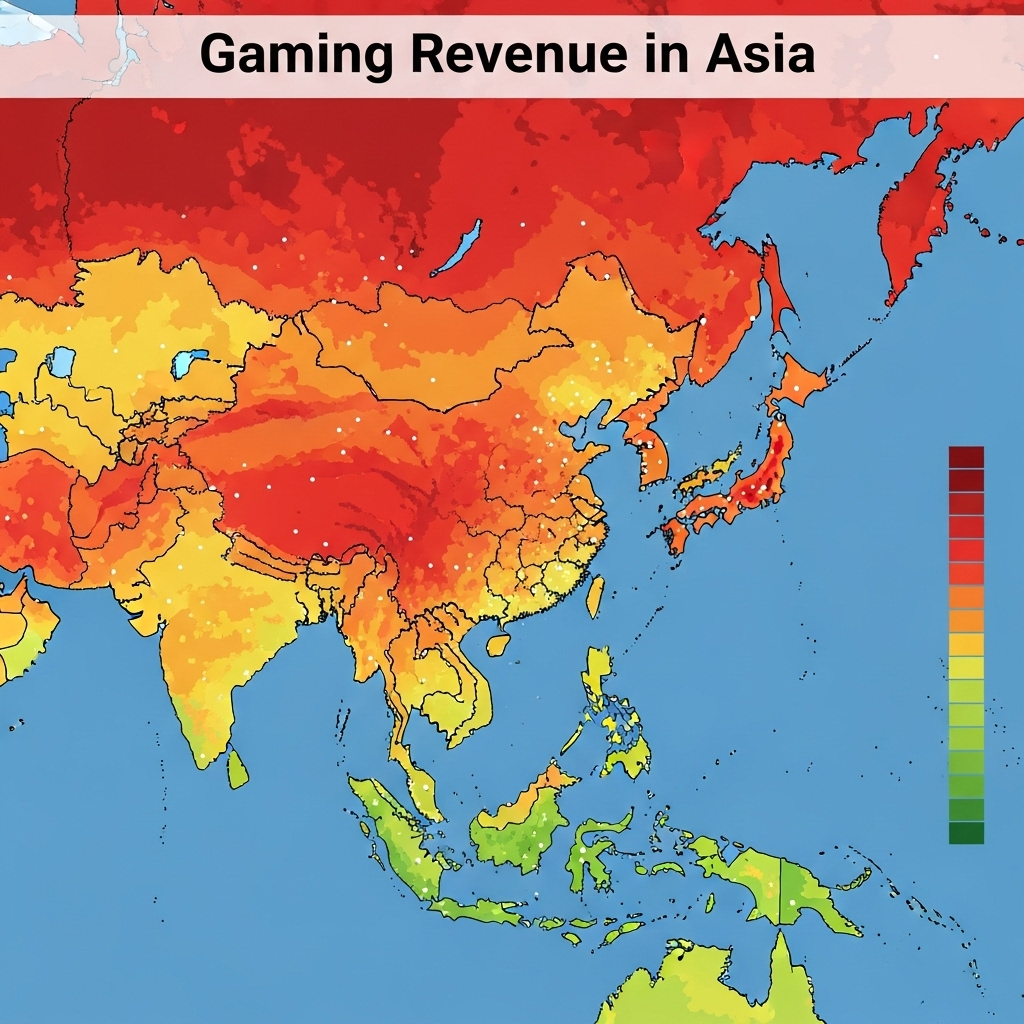The Asia-Pacific region’s commanding 41% share of the global gaming market, projected to reach over $86 billion by 2025, represents more than just impressive statistics—it reflects fundamental cultural, technological, and economic factors that have positioned this region as the epicenter of gaming innovation and consumption. With over 1.7 billion gamers across countries from Japan to Indonesia, the APAC region has redefined what gaming means in the 21st century.
Economic Factors Driving Growth
The economic dynamics of the Asia-Pacific gaming market differ fundamentally from Western markets. The region’s rapid economic development has created a massive middle class with disposable income for entertainment, but the relatively lower cost of living means that gaming represents an affordable luxury. In countries like Vietnam and the Philippines, where a gaming console might cost several months’ wages, mobile gaming on devices people already own for communication has become the dominant platform.
The free-to-play model pioneered and perfected in Asia has proven extraordinarily successful in markets where upfront game purchases were historically uncommon. Games like Honor of Kings in China generate billions in revenue without charging for initial download, instead monetizing through cosmetics, battle passes, and convenience items. This model aligns perfectly with Asian consumers’ preference for trying products before committing financially.
Digital payment infrastructure in Asia has leapfrogged traditional banking systems, with mobile payment platforms like Alipay, WeChat Pay, and GrabPay making in-game purchases frictionless. The integration of gaming into super-apps means that the same platform used for messaging and food delivery also facilitates game payments, reducing transaction barriers that might exist in markets dependent on credit cards.
Cultural Attitudes Toward Gaming
Gaming in Asia-Pacific has achieved mainstream cultural acceptance that surpasses even the most gaming-friendly Western nations. In South Korea, professional gamers are celebrities with endorsement deals and television shows. Chinese parents send children to esports training camps hoping they’ll become professional players. This cultural validation has removed stigma that might limit gaming in other regions.
The collectivist nature of many Asian societies has shaped gaming preferences toward social and competitive experiences. Multiplayer games dominate the charts, with titles like PUBG Mobile and Mobile Legends serving as social platforms where friends gather virtually. Gaming isn’t seen as solitary escapism but as social participation, similar to playing sports or attending concerts in Western cultures.
The concept of “face” and social status plays a crucial role in Asian gaming monetization. Cosmetic items that display wealth or achievement are highly valued, with players spending significant amounts on purely aesthetic upgrades. Limited edition skins or rare characters become status symbols within gaming communities, driving monetization in ways that might seem irrational to Western observers but make perfect sense within Asian social contexts.
Mobile-First Gaming Revolution
The Asia-Pacific region’s embrace of mobile gaming has been absolute and transformative. With smartphone penetration exceeding 70% in most countries and 5G networks rapidly deploying, mobile devices have become the primary gaming platform for hundreds of millions. This mobile-first approach has influenced game design globally, with successful Asian mobile games setting templates that Western developers now follow.
The commute culture in densely populated Asian cities has created perfect conditions for mobile gaming adoption. Long train rides in Tokyo, traffic jams in Jakarta, and bus commutes in Bangkok provide daily gaming opportunities. Games are designed around these use cases, with session lengths and progression systems optimized for intermittent play during commutes.
Internet cafes and gaming centers remain vital to Asian gaming culture despite widespread smartphone adoption. These venues provide high-end gaming experiences for players who cannot afford expensive hardware, social gathering places for gaming communities, and platforms for competitive play. The PC bang culture in South Korea and internet cafe scene in Southeast Asia have no true Western equivalent, creating unique gaming ecosystems.
Esports as National Priority
Esports in Asia-Pacific has transcended entertainment to become a matter of national pride and economic strategy. Governments actively support esports through funding, infrastructure development, and inclusion in educational curricula. The Asian Games inclusion of esports as a medal event legitimized competitive gaming at the highest levels of international sport.
The infrastructure supporting Asian esports is unparalleled globally. Purpose-built esports stadiums in cities like Shanghai, Seoul, and Taipei host events attended by thousands and watched by millions online. Professional teams operate from dedicated training facilities with coaches, analysts, and support staff rivaling traditional sports organizations. This professionalization has elevated play quality to levels that dominate international competitions.
Streaming culture in Asia has created ecosystems where professional gaming is economically viable for thousands of players. Platforms like Douyu, Huya, and AfreecaTV enable players to monetize their skills through streaming, creating career paths beyond just tournament winnings. Virtual gifting systems where viewers purchase digital items to support streamers have generated billion-dollar economies.
Regional Variations and Preferences
While often grouped together, Asia-Pacific markets exhibit distinct gaming preferences shaped by local culture and economics. Japan favors single-player RPGs and narrative-driven experiences, maintaining vibrant console and handheld gaming markets. China dominates in competitive multiplayer and social gaming, with massive player bases for MOBAs and battle royales. Southeast Asia shows strong preference for mobile MOBAs and battle royales with lower system requirements.
The gacha mechanic, originating in Japan, has become a defining feature of Asian mobile games. This lottery-style system for acquiring characters or items taps into gambling psychology while skirting legal restrictions. Games like Genshin Impact have refined gacha systems to feel fair and rewarding while generating massive revenues. Western markets have been slower to accept these mechanics, viewing them as potentially exploitative.
Payment preferences vary significantly across the region. While credit cards dominate in Japan and Singapore, prepaid cards remain popular in countries with lower banking penetration. Carrier billing, where game purchases are added to phone bills, is common in markets like Thailand and Indonesia. This payment diversity requires sophisticated billing systems for games to succeed across the entire region.
Technology Leadership and Innovation
Asia-Pacific’s technology leadership extends beyond just consumption to innovation in gaming technology. Chinese companies like Tencent and NetEase have become global gaming powerhouses through acquisition and development. Korean companies pioneered online gaming infrastructure that Western markets later adopted. Japanese companies continue to define console gaming hardware and software innovation.
5G deployment in Asia is ahead of most Western markets, with South Korea, China, and Japan leading global rollout. This next-generation connectivity enables cloud gaming, augmented reality experiences, and massive multiplayer games that aren’t yet feasible in regions with slower networks. Asian developers are creating games that leverage these capabilities, setting templates for global gaming’s future.
Artificial intelligence integration in Asian games has advanced rapidly, with Chinese companies particularly aggressive in implementing AI for personalization, matchmaking, and content generation. The vast player populations provide training data for machine learning systems that improve game experiences. This AI advantage may prove decisive as gaming becomes increasingly algorithmic.
Regulatory Landscape and Challenges
Government regulation significantly impacts Asian gaming markets, with approaches varying from Korea’s late-night gaming shutdowns for minors to China’s strict approval process for new games. These regulations shape game design, with developers creating systems that comply with local laws while maintaining engagement. Time limits, spending caps, and age verification systems are built into games from conception rather than added retroactively.
The Chinese gaming license freeze of 2018-2019 demonstrated regulatory risks in Asian markets. Thousands of games waited in approval queues while companies pivoted to international markets. This experience has encouraged Asian developers to think globally from inception, creating games that can succeed internationally if domestic markets become restricted.
Gambling laws across Asia significantly impact game design, with developers carefully navigating what constitutes gambling versus entertainment. Loot boxes, gacha systems, and chance-based mechanics are designed to comply with varying regional interpretations of gambling law. This regulatory complexity has created expertise in monetization design that carefully balances engagement with compliance.
Market Entry Strategies
Success in Asian gaming markets requires deep cultural understanding and localization beyond simple translation. Character designs that resonate in Japan might fail in Indonesia. Monetization strategies successful in China might be rejected in India. Companies entering Asian markets must understand these nuances or partner with local publishers who do.
The importance of local partnerships cannot be overstated for Western companies entering Asian markets. Regulatory requirements, payment processing, and marketing channels often require local expertise. Successful partnerships like Activision-Blizzard with NetEase in China demonstrate how Western games can succeed in Asia through appropriate partnerships.
Marketing in Asian gaming markets emphasizes different channels than Western markets. Influencer marketing through KOLs (Key Opinion Leaders) in China, LINE messaging app in Japan, and WhatsApp in Southeast Asia require platform-specific strategies. Traditional advertising is less effective than community building and word-of-mouth marketing in most Asian markets.
Future Trajectories
The Asia-Pacific gaming market’s growth trajectory shows no signs of slowing, with emerging markets like India and Indonesia representing massive untapped potential. As internet infrastructure improves and smartphone costs decrease, hundreds of millions of new players will enter the market. These players will shape gaming’s future through their preferences and behaviors.
The convergence of gaming with other entertainment forms is accelerating in Asia. Games become anime, anime becomes games, and both integrate with music and merchandise in transmedia franchises. This holistic approach to intellectual property development, perfected by Japanese companies and adopted across Asia, represents gaming’s future as lifestyle brands rather than isolated products.
Technological advantages in 5G, AI, and mobile payments position Asia-Pacific to maintain gaming leadership. As gaming becomes increasingly cloud-based and AI-driven, regions with advanced infrastructure and large player populations for training AI systems will have inherent advantages. The Asia-Pacific region’s combination of technology, population, and gaming culture suggests its dominance will not only continue but accelerate.





